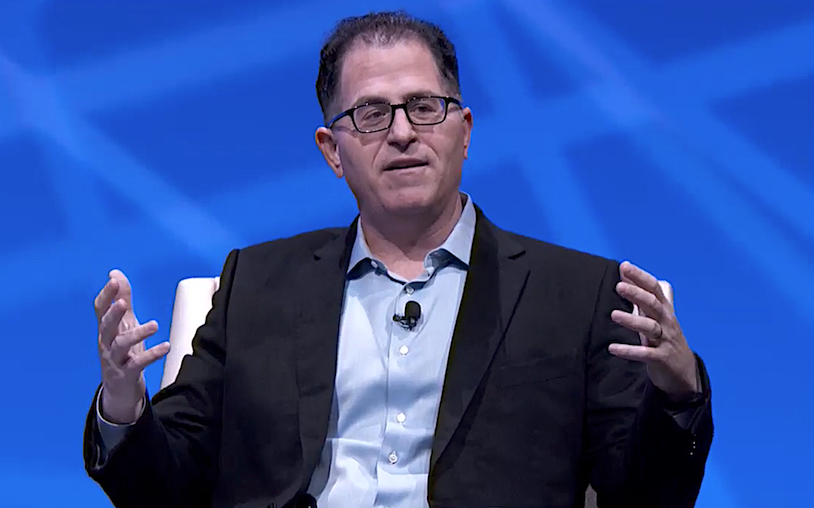 INFRA
INFRA
 INFRA
INFRA
 INFRA
INFRA
Dell Technologies Inc. slipped to a loss in the second fiscal quarter of 2018 and said enterprise storage revenues undershot targets, but investors seemed largely unfazed, boosting the stock about a half-percentage point in early New York Stock Exchange trading.
Consolidated revenue rose 48 percent from a year ago, to $19.3 billion, and gross margins doubled to $4.8 billion. Dell cautioned that year-over-year comparisons aren’t meaningful, however, since last year’s results don’t reflect the full contribution of EMC Corp., which was acquired a year ago today.
Executives said they were pleased with overall performance, particularly in light of what Chief Financial Officer Tom Sweet called “the most challenging cost environment in over a decade.” The shortage of DRAM [dynamic random access memory] memory, in particular, has made pricing difficult, and Sweet said high memory costs are expected to be a fact of life for the remainder of the year. “We have adjusted prices a number of times, making sure we aren’t dampening demand,” Sweet said. “In general, we’ve seen reasonably good success navigating through this.”
Dell has big ambitions to remain relevant in the cloud computing era. At the recent VMworld user conference in Las Vegas, Dell founder and Chief Executive Michael Dell (pictured) said the company is aiming to help companies with the reality that they need to have operations both in the public cloud and their own data center for the foreseeable future. “You’ll have a different kind of cloud emerge,” he said, and Dell is looking to supply all the pieces needed to make it work.
The best news for the company was on the desktop front, where revenue of $9.9 billion grew 7 percent and stood at the highest level since the second quarter of fiscal 2015. Operating income in the group rose 17 percent, to $566 million. Dell said it continues to steal market share from competitors, with 18 consecutive quarters of year-over-year PC unit share growth and its highest market share since 2006. Its 3.7 percent increase in shipments contrasts with worldwide declines of 3.1 percent forecast by International Data Corp.
Sales in the enterprise-oriented Infrastructure Solutions Group grew 7 percent, to $7.4 billion, with server and networking revenue leading the way on a year-over-year increase of 16 percent. Storage revenue totaled $3.7 billion, but cannot be meaningfully compared year-earlier figures before the close of the EMC deal.
Executives said storage is not yet hitting its mark, however. Dell EMC President David Goulden said storage orders declined in the mid-single digits, consistent with the previous two quarters. “It’s clearly an area of the market where we’re not performing as well as we should,” added Tyler Johnson, senior vice president and treasurer of Dell Technologies.
The slide in storage sales is not indicative of a dip in demand as much as a shift to new flexible consumption models that spread customer payments over a longer period, Goulden said on the earnings conference call. The benefits of better long-term customer relationships are somewhat offset by delayed revenue recognition. Dell EMC’s performance in its growth storage businesses continues to be strong, Goulden said. Sales of flash arrays were twice that of the company’s closest competitor and storage unit orders grew overall, he said. Flash now represents the majority of enterprise shipments and is “starting to take a significant part of the midmarket as well,” he said.
However, the company needs to turn around the continuing decline in storage sales volume, which it plans to do in large part by focusing on midsized business markets. Goulden said the company is adding “several hundred storage specialists,” beefing up its channel teams and changing sales quotas. “We believe investments in the mid-market is what will help us do better in the second half than we did in the first,” he said.
Dell paid down an additional $1 billion of debt and finished the quarter with cash and investments of $15.3 billion. The company has now paid down $9.5 billion of its total debt and repurchased 19.7 million shares of its common stock. Its long-term debt stands at $41.4 billion, down from $43 billion two quarters ago.
One bright spot in the server market was Dell EMC’s VxRail hyperconverged appliance, which now has 14,000 nodes deployed to more than 2000 customers. The company said it also saw double-digit demand growth for its new Isilon network-attached storage.
Another plus was an agreement announced today with General Electric Co. that effectively makes Dell the industrial giant’s principal computing infrastructure provider. It’s the largest nongovernment contract Dell has ever signed, and it’s emblematic of the synergy that results from the combination of Dell and the EMC Federation, Sweet said. “Our goal in this first year was to realize the benefits of the combination, and I think we’ve done that,” he said.
Dell spoke to SiliconANGLE Media video unit theCUBE at VMworld last week:
THANK YOU